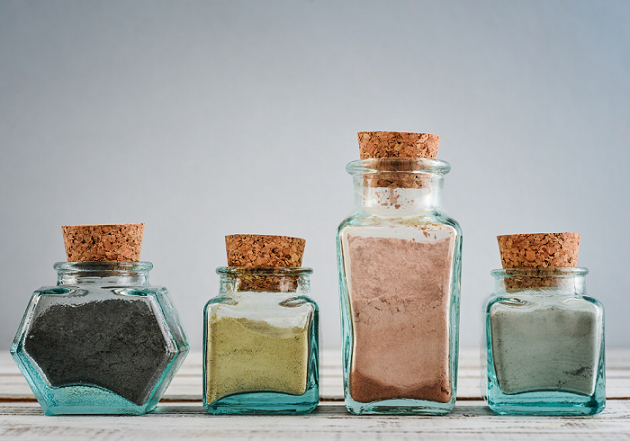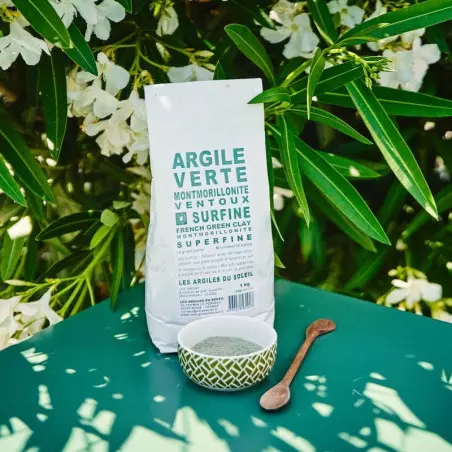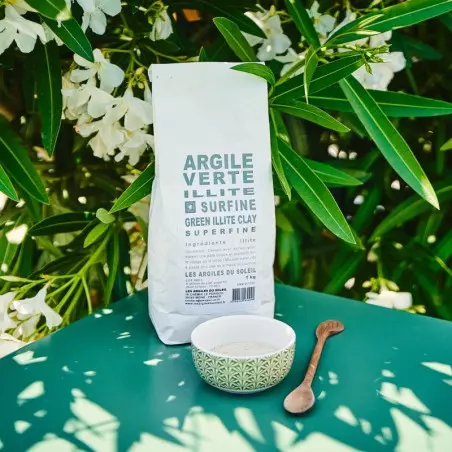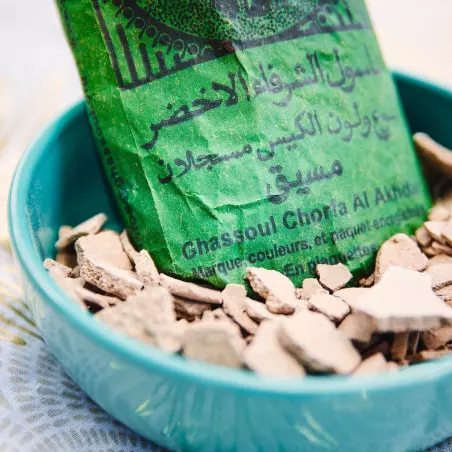It looks like your message was cut off. Could you please provide the complete text you would like translated from French to English?clay It is a treatment used worldwide since ancient times. It is a versatile natural remedy that proves to be useful in many cases. Economical, simple, natural, easy to use, and safe, clay is a panacea. It can be used during pregnancy, postpartum, and is also useful for the care of babies and children in naturopathy.
It is a sedimentary rock rich in numerous minerals and trace elements, which vary depending on the type and source of the chosen clay. It can be used in different ways: externally and even internally, as suggested by many traditional uses. Its main properties are absorbent, adsorbent, mineralizing, but it is also antiseptic, healing, soothing, degreasing, exfoliating, cleansing, calming, purifying... its benefits are numerous and its uses are vast, making it an ideal treatment, including during pregnancy.
Clay is used for health, beauty, and the home of pregnant women, baby and the family in general: a must-have in every bathroom.
It can be used:
- in case of emergency care for burns or cuts
- for dental care or to relieve canker sores
- for the preparation of numerous cosmetic treatments for pregnant women: the face, the body, and the hair
- for baby and child care
- for the house in natural stain remover or odor absorber
Properties:
- Absorbent: Thanks to its absorbent power, clay absorbs toxins as well as excess sebum.
- Adsorbent: By binding toxins, clay promotes their elimination.
- Bactericidal and antiseptic, healing: It promotes healing and cellular regeneration. Therefore, it is perfectly suitable for cleaning and healing a small wound or cut when used as a poultice.
- Moisturizing and softening: It deeply nourishes the skin and acts as a true beauty treatment for all skin types, provided it is used correctly and not allowed to dry out.
- Relaxing: It proves to be very useful for relieving back pain, rheumatism... or simply taking a clay bath to relax after a long day, especially during pregnancy.
How to use clay during pregnancy ?
As with outside of pregnancy, clay requires some usage precautions:
- One always chooses a high-quality clay, especially for internal use, where one can opt for an ultra-fine clay powder.montmorillonite for example)
- Materials made of wood, glass, or possibly plastic are used to handle, mix, store, and apply clay: bowl, spoon, jar, box, pot...
- We avoid the use of metal because of the properties of the clay itself.
- If you wish to prepare your mask or shampoo in advance, opt for an airtight container to prevent your preparation from drying out. You can always adjust the preparation at the last minute by adding a bit of water to moisten it or adding a bit of clay to thicken it if the preparation is too liquid.
One can use clay:
- PURE in powder form: sprinkle directly onto the scalp, on a small wound for example.
- DILUTED In a little water to prepare a paste, a poultice, a plaster: you mix the clay with water in a container and apply it to the skin or in a compress or cloth on the area to be treated.
- MIXED In your skincare and cosmetics: you can add a bit of clay to a shampoo, a cream, a homemade preparation, or a store-bought one.
In external route:
- In cosmetic care: for a complete beauty routine, clay is used to clean the skin and gently eliminate dead skin cells, to alleviate minor issues of oily skin, acne, pimples, redness, pregnancy mask, but also as toothpaste, shampoo, quick skin application, mask... Depending on the use, you will use the mineral powder or prepare a paste, or incorporate the clay into your care routine.
- In healing: direct application of clay on small wounds, cuts, or burns, for example.
- As a poultice: for slightly more significant injuries, joint pain, lower back pain, or even on a boil.
!!! Consider placing the clay in a compress; it's much easier to remove and clean.
Internally:
- Clay water, not clay milk, can be used for a gentle detox treatment: be careful, during pregnancy, internal use should be limited to short periods and only with very high-quality clays.
It is common to say that clay is not recommended for internal use. during pregnancy, however, specialists recommend it in certain cases. I encourage you to use common sense and do your research to make informed decisions, as always! See the work of Dr. Jade Allègre.
Generally speaking:
The clay powder is mixed with water to form a paste that is more or less liquid depending on the use.
- For a shampoo, the preparation can be quite liquid, whereas for a mask or a poultice, a less liquid preparation will be made to prevent it from running and to allow for the application of a thick layer.
- Next, apply the preparation to the affected area and let it sit for a few minutes for daily care, or for several hours for certain poultices.
- Then, the clay is removed by wiping with water, a cloth, a washcloth. Do not let the clay dry., this could risk dehydrating the skin and it is very unpleasant. You can use a water or hydrosol spray to keep the mask moist.
- Once used, the clay is discarded (in the compost, in the garden, or in the trash): a mask or poultice is never reused, as it is already loaded with toxins and other harmful substances expelled by the body and trapped .
- For small scars, you can sprinkle powdered clay. There's no need to clean deeply. You can leave some clay particles to act with their purifying properties.
- You can also use powdered clay for a dry shampoo: sprinkle a spoonful ofclay at the base of the hair, the scalp is massaged, then brushed to naturally remove the clay.
- If you make large poultices, throw the clay into the compost or the trash, but avoid rinsing large quantities down the drains.
- You can also use compresses or a cloth for poultices. It is much more practical and easy to use.
During pregnancy, one should avoid:
- Important poultices on the abdominal area
- Prolonged or intense internal use
Is it safe to eat clay during pregnancy ?
It's a thorny question.
The official response could be no: avoid internal use. during pregnancy. . Seek medical advice To a healthcare professional and do some research.
Many specialists agree that clay can be used internally during pregnancy. We will set aside the traditional use in certain regions, particularly in Central Africa, Cameroon, or Senegal, where many women consume large quantities of clay during pregnancy. First of all, internal use should always be avoided in cases of a history of intestinal obstruction. One should start very gently with light dosages to observe the effects. If one wishes to use clay internally during pregnancy, one should opt for clay water, and not for clay milk : Mix 1 teaspoon of clay in a glass of water (using a wooden spoon) and let it sit overnight. The next morning, drink the water and leave the clay at the bottom of the glass. This clay can be used as a face mask or as a poultice if you wish.. We will repeat the operation in a few days.
Alternatives to clay: Also consider plants, nutrition, and other natural remedies to take care of yourself and your baby.
Always observe the effects and your feelings. And of course, be accompanied by a naturopath specialized in pregnancy, in order to receive tailored and personalized advice.
What type of clay should be favored during pregnancy ?
There are many types of clay in the world.
All clays are usable for our future mother during pregnancy, but it is important to choose quality clays. There are clays of different colors: green, white, red, pink, yellow, blue.
Focus on 3 well-known types of clay:
Green montmorillonite clay: Highly adsorbent. Very pure, rich in magnesium and silica, it is prized for its absorbent properties and is the most commonly used type of clay. This clay can absorb 10 to 50 times its volume in water.
Illite clay: rich in trace elements, in minerals such as calcium or magnesium, Green illite clay allows for use in many applications. It can be used on pigment spots and pregnancy masks.
Rhassoul: used in Morocco, will be preferred for hair care and body care. For hair, rhassoul is suitable for sensitive scalps, in case of dandruff or oily hair.
What natural remedies can help prevent nausea during pregnancy ?
Nausea is quite common, especially in early pregnancy. Nausea is often a message from the body inviting us to become aware of an internal imbalance.
At the physical level, it is often an overload at the level of the liver.
We can therefore help the body and relieve nausea by supporting liver activity in an appropriate and personalized way through dietary advice, gentle detox, plants, massages, exercises such as certain yoga or Pilates postures, etc.
You can try mint tea, lemon tea (preferably organic lemon), or ginger tea.
But of course, the ideal would be to make a detox before pregnancy to act in a preventive manner.
And in case of nausea during pregnancy, take action to relieve the symptoms but especially to ease the liver's workload, by adapting the protocol to the pregnancy, of course.
On an emotional level, Sometimes, nausea can occur when the pregnancy is not yet fully integrated, completely embraced, or accepted. This is probably one of the reasons why nausea often eases and disappears around the third month of pregnancy, when the pregnancy is finally announced and the belly starts to round out.
Get support to prepare for a pregnancy and to avoid or limit the risk of nausea during pregnancy, because it is never too late !
How to use clay on babies ?
We like to seek natural remedies to take care of our children, and that's completely normal.
What could be more natural than clay ?
Clay can be used in various ways for the care of babies and children. Soothing, healing, anti-inflammatory, purifying, disinfecting, natural, and safe... clay is beneficial for both adults and children from a very young age.
A true treasure of nature, clay is useful for daily care, prevention, treatment, and even as an emergency remedy. Don't overlook clay when it comes to taking care of your children !
For the newborn:
- Very quickly, we will be able to use clay for the care of very young children: we can apply a little bit of superfine clay powder to the area of the umbilical cord to promote healthy healing.
- We can use clay for Sure, please provide the text you would like to be translated from French to English. and baby's bottom: white clay powder will be preferred and will serve as a good alternative to the good old talcum powder. In case ofErythema Buttocks, clay will promote the healing and regeneration of epidermal cells. Alternating with a good liniment (why not homemade?) and, of course, leaving the baby's bottom exposed for proper healing, clay will be an excellent complement, especially when the baby is wearing diapers.
- To relieve the skin irritations in the folds: neck, armpits, groin, thighs... These irritations are often related to stagnant moisture: sprinkle a small amount of clay powder to absorb the moisture and keep the baby dry. Its anti-inflammatory and healing properties will be useful.
When the child grows up:
- Next, clay can be used on children in case of a minor injury: a pinch of powdered clay on a scrape, scratch, or small cut stops the bleeding. I always had a small amount of green clay in my handbag, in a small glass bottle, when my daughters were little. It is very effective for stopping bleeding and relieving minor everyday injuries.
- For minor burns and cuts, you can also try a clay poultice, if your child agrees to keep it on! This can soothe the pain, especially in the case of burns. In this case, prepare the poultice with very cool water and renew it regularly. You could add a bit of mint tea, which is refreshing, and lavender tea to moisten the clay and combine their properties. Of course, in the case of severe burns or deep cuts, clay is not enough !
- In the case of chickenpox or weeping eczema, a bit of superfine clay powder can help relieve and support healing. Of course, additional complementary advice may also prove useful.
- For the playful side: in the summer, play in the garden with some clay, near a basin of water. Draw on your body, let your children mix and play with the clay, apply it on yourself or on themselves, draw on the trees, or even make little sculptures and artistic pottery suitable for their age !
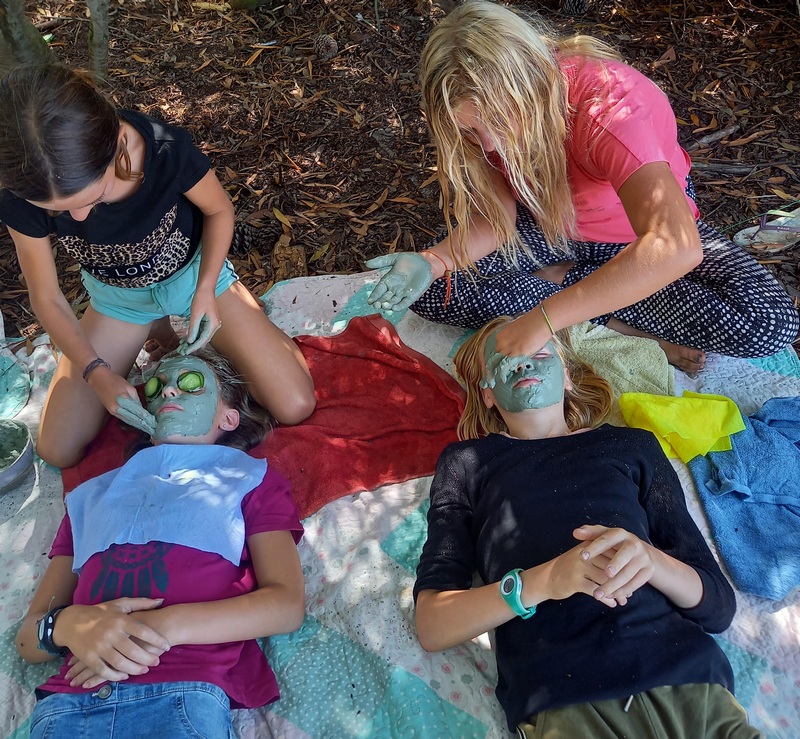
The material is pleasant to touch and allows children to have fun safely with a non-toxic product, free of dyes and chemicals. Different colored clays can be used, painting can be done with them, and children can be encouraged to be creative. You just need to be organized to avoid making a mess !
If you familiarize your child with these natural remedies from a young age, they will learn to use them on their own and will quickly know how to sprinkle a bit of clay on minor injuries or prepare a clay paste to make a poultice, apply it for fun, or make a beauty mask for mom !
What type of clay should you choose for a baby ?
I recommend choosing a superfine clay powder for a gentler use on the baby.
We often use dry clay powder directly on the areas to be treated, or we dilute it with a bit of water to make a paste and apply a poultice to the area to be treated.
One should never let the clay dry on the skin and reapply as often as necessary.
To summarize:
- Use clay for daily care and as cosmetic products to have beautiful skin and lovely hair, during pregnancy, postpartum, and for the baby.
- Always have some clay on hand for minor injuries, especially as the baby grows.
- Treat yourself to the soft texture of clay as a mask, for skincare, or for playing in the garden or by the river during the summer !
- Choose high-quality clays for safe use and a fine or superfine clay for the most pleasant care !
I support you during individual consultations and stages in pre-conception, during pregnancy, postpartum, and in naturopediatrics.
The health of our children is a priority.
